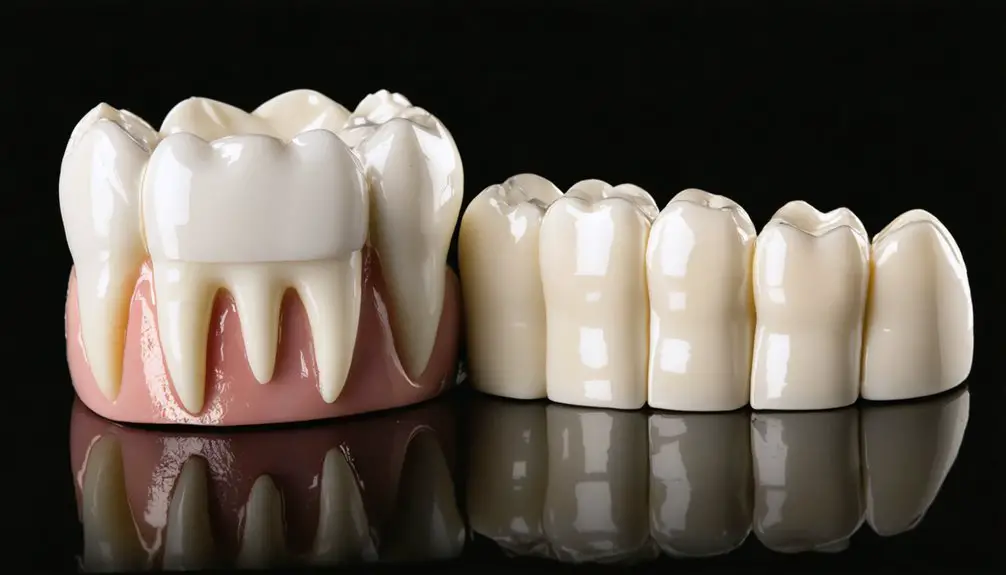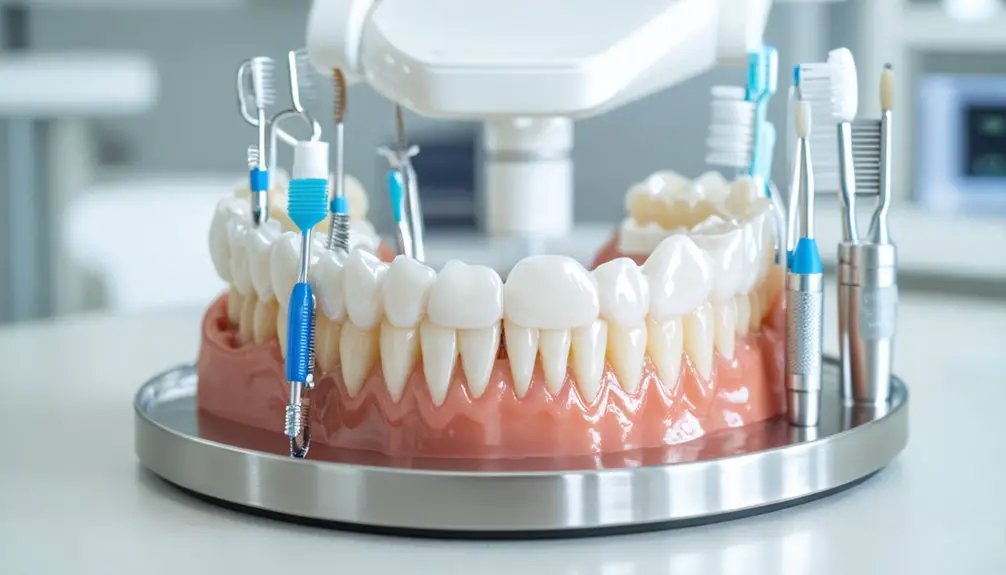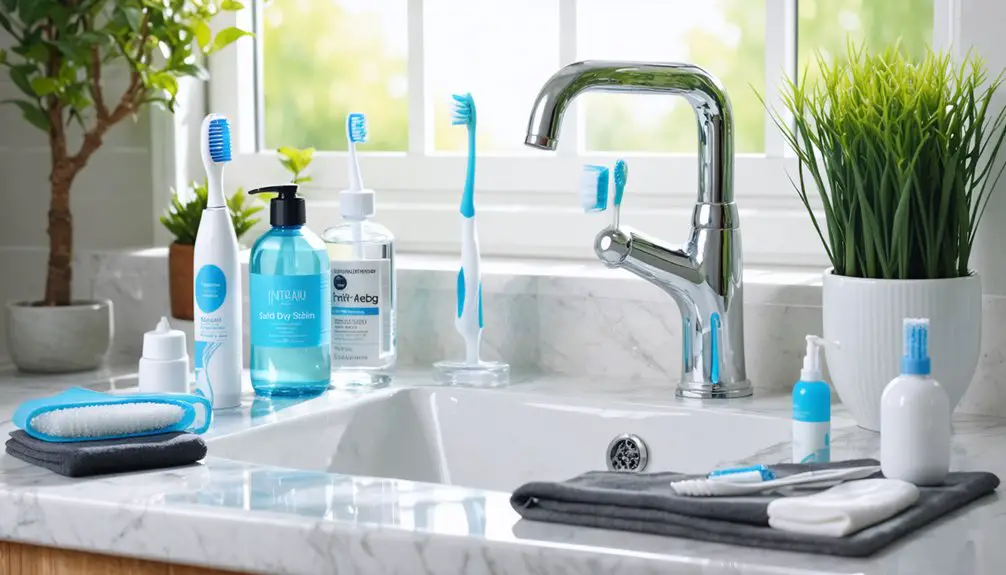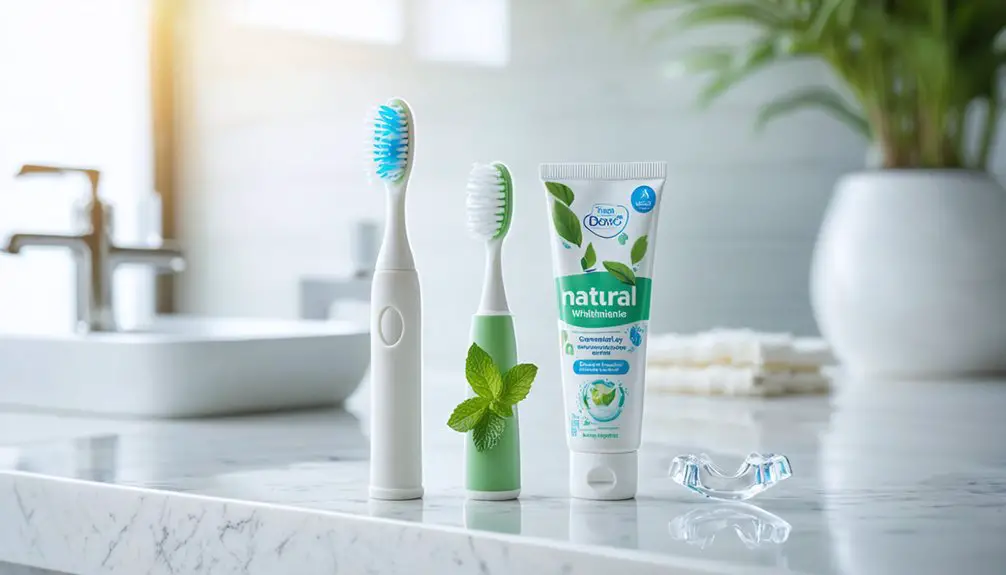If you have crowns or fillings, teeth whitening won’t affect these restorations, potentially causing color mismatches with your natural teeth. You’ll need to consult your dentist before starting any whitening treatment to assess your specific situation and discuss possible restoration replacements. Professional treatments are safer than DIY methods, as they minimize risks like sensitivity and gum irritation. A thorough pre-whitening dental exam can help identify potential complications and create the best treatment plan for your smile.
Key Takeaways
- Consult a dentist before whitening to discuss potential restoration replacements, as crowns and fillings won’t change color with treatment.
- Use custom-fitted trays instead of over-the-counter strips to prevent whitening gel contact with restorative materials.
- Consider replacing old restorations after whitening to match your newly brightened natural teeth color.
- Choose professional whitening treatments over DIY methods for better control and reduced risk of damage to restorations.
- Complete necessary dental work and repairs before starting any whitening treatment to ensure optimal results.
Understanding Crown and Filling Reactions to Whitening
While teeth whitening can effectively brighten your natural teeth, it’s important to understand that crowns and fillings won’t respond to whitening treatments.
These dental restorations are made from materials like porcelain and ceramic that have sealed, smooth surfaces resistant to whitening agents. Your natural tooth enamel will lighten, but crown materials and fillings maintain their original shade. Professional in-office treatments using powerful peroxide gels and special lights deliver the most dramatic whitening results.
Unlike natural teeth, dental crowns and fillings made from porcelain or ceramic won’t respond to whitening treatments, keeping their original color.
This difference in whitening response can create noticeable color mismatches between your natural teeth and existing restorations. It’s best to complete any teeth restoration work before beginning a whitening treatment.
Though whitening won’t structurally damage your crowns or fillings, peroxide-based treatments may cause minor surface softening of restorative materials.
If you’re planning to whiten your teeth, consider consulting your dentist first to discuss potential restoration replacements needed to maintain aesthetic harmony after treatment.
Key Warning Signs During Teeth Whitening
When whitening your teeth, you’ll need to watch for key warning signs that indicate potential problems, including sudden sharp pain when consuming hot or cold items and visible swelling or bleeding of your gums.
Professional whitening treatments performed by dentists are safer than DIY methods for achieving optimal results while minimizing risks.
You should immediately stop treatment if you experience persistent sensitivity lasting more than a few hours or notice any irritation of the soft tissues in your mouth. Both hydrogen peroxide and carbamide peroxide can cause tooth sensitivity during whitening treatments.
If you observe uneven color development, particularly around existing dental work like crowns and fillings, you’ll want to consult your dentist to evaluate the treatment’s compatibility with your restorations.
Sudden Sharp Tooth Pain
Sharp tooth pain during teeth whitening serves as a critical warning sign that shouldn’t be ignored. When you experience sudden “zingers” or tooth sensitivity, it often indicates that whitening agents have penetrated your enamel, reaching sensitive nerve endings.
These intense sensations typically occur when hydrogen peroxide gels create microscopic pores in your tooth structure. While short-term pain is normal, most zingers resolve within 24-48 hours after treatment.
You’ll notice whitening pain most commonly when your teeth contact hot, cold, or sweet substances, or during routine activities like brushing and flossing.
If you have thin enamel, existing cavities, or untreated cracks, you’re at higher risk for developing severe sensitivity. Temporary nerve inflammation inside teeth can result from aggressive bleaching treatments.
To protect yourself, always undergo a dental checkup before whitening, use lower concentration products, and follow professional application guidelines.
Consider incorporating desensitizing treatments to minimize discomfort and support enamel recovery.
Gum Swelling or Bleeding
A concerning sign during teeth whitening is the development of swollen or bleeding gums, which often indicates chemical irritation from whitening agents.
When whitening gel contacts your gum tissue, it can cause chemical burns, especially if you’re using poorly fitted trays or applying too much product.
High-concentration peroxide products increase the risk of gum tissue damage and infection.Custom-fit trays provide the best protection against gum irritation during whitening treatments.
Watch for these warning signs of gum irritation:
- Redness and swelling around tooth margins where you’ve applied whitening gel
- Burning sensations or white patches on gum tissue
- Increased sensitivity when brushing or flossing
- Development of blisters or peeling tissue
If you experience these symptoms, stop whitening immediately and rinse with warm salt water.
Apply soothing gels like aloe vera to affected areas, and seek professional dental care if symptoms persist or worsen.
Uneven Color Development
Despite proper application techniques, uneven color development remains one of the most common complications during teeth whitening treatment.
If you’re using whitening products while having dental restorations, you’ll notice that crowns, veneers, and fillings don’t respond to bleaching agents, creating noticeable color inconsistency across your smile. Your tooth enamel’s natural variations in thickness and mineral content can also lead to patchy results. Poor dental hygiene can worsen these color inconsistencies and make whitening results more unpredictable.
Using a sonic whitening toothbrush during your whitening treatment can help remove surface stains more effectively and promote even results.
To maintain color consistency during whitening, you’ll need to take into account several factors.
Irregular gel application, imperfect tray fit, and lifestyle habits like coffee consumption can all contribute to uneven results. Professional supervision and custom-fitted trays offer the most reliable whitening techniques.
If you notice white spots, streaks, or blotchy areas developing, it’s essential to adjust your treatment approach or consult your dentist for guidance.
Protecting Your Dental Work While Brightening
When whitening your teeth with dental work present, you’ll need to take specific precautions to protect your restorations from potential damage.
Using custom-fitted trays helps minimize contact between whitening agents and your crowns or fillings while ensuring even coverage of natural teeth.
You should strictly follow exposure time guidelines and avoid direct application of whitening gel to restorations, as peroxide-based agents can soften restoration materials and lead to surface degradation over time.
Safe Whitening Application Methods
The successful protection of dental restorations during teeth whitening depends on choosing appropriate application methods and following professional guidelines.
Custom trays fitted by your dentist provide ideal control of peroxide concentration and gel placement, ensuring the whitening agent stays on your natural teeth while minimizing contact with crowns and fillings.
- Use dentist-prescribed custom trays for 2-4 hours daily or overnight as directed to prevent sensitivity and protect restorations.
- Apply protective barriers around crowns and fillings during in-office treatments to shield them from high-concentration bleaching agents.
- Follow precise application instructions with ADA-approved strips or gels to avoid compromising bonding materials.
- Schedule regular dental checkups to monitor your restoration integrity and adjust whitening protocols as needed for ideal results while maintaining dental work safety.
Crown Material Protection Tips
Protecting your crown materials during teeth whitening requires specific preventive measures and careful planning. Before starting any whitening treatment, you’ll need to consult your dentist to evaluate your crowns and develop a tailored approach.
For effective crown maintenance, use custom-fitted trays that prevent whitening gel from contacting crown surfaces, and avoid over-the-counter strips that can’t distinguish between natural teeth and dental work.
If you’re concerned about discoloration, focus on preventive care by using soft-bristled brushes and non-abrasive toothpaste. Reduce exposure to staining substances like coffee, tea, and wine.
When whitening alternatives become necessary, consider professional cleaning to remove surface stains. If color matching remains an issue after whitening natural teeth, crown replacement may be your most reliable solution for achieving uniform brightness.
Professional vs. At-Home Whitening Safety

Modern clinical research clearly demonstrates significant safety differences between professional and at-home teeth whitening approaches.
Professional whitening offers superior safety profiles with precise control over peroxide concentrations and application methods, while at-home treatments carry higher risks when misused.
- Professional treatments show no significant long-term damage to enamel or pulp, with sensitivity issues being mild and temporary.
- At-home products vary widely in quality, with sensitivity rates reaching up to 80% in some cases.
- Professional supervision guarantees proper technique and immediate intervention if needed.
- Over-the-counter products require strict adherence to instructions to prevent enamel damage.
For maximum at-home safety, always choose ADA-approved products and follow instructions carefully.
Consider professional evaluation before starting any whitening regimen, especially if you have existing dental work.
Preventing Color Mismatch Between Natural Teeth and Restorations
While professional whitening offers controlled results, managing color consistency between whitened natural teeth and existing restorations presents unique challenges.
To achieve ideal color harmony, you’ll need both instrumental measurements and visual assessment under standardized lighting conditions. The key is selecting composites that match your patient’s natural tooth shade and maintaining consistent evaluation methods.
When choosing restorative materials, consider that single-shade composites typically appear whiter than natural teeth, while universal composites show better color stability and blending.
You’ll find that smart chromatic composites maintain consistent color matching regardless of cavity depth.
Remember that although spectrophotometric measurements might show acceptable ΔE values (under 3.3), visual assessments often reveal subtle mismatches.
Regular monitoring of composite selection and placement techniques helps promote lasting aesthetic results.
Essential Pre-Whitening Dental Checks
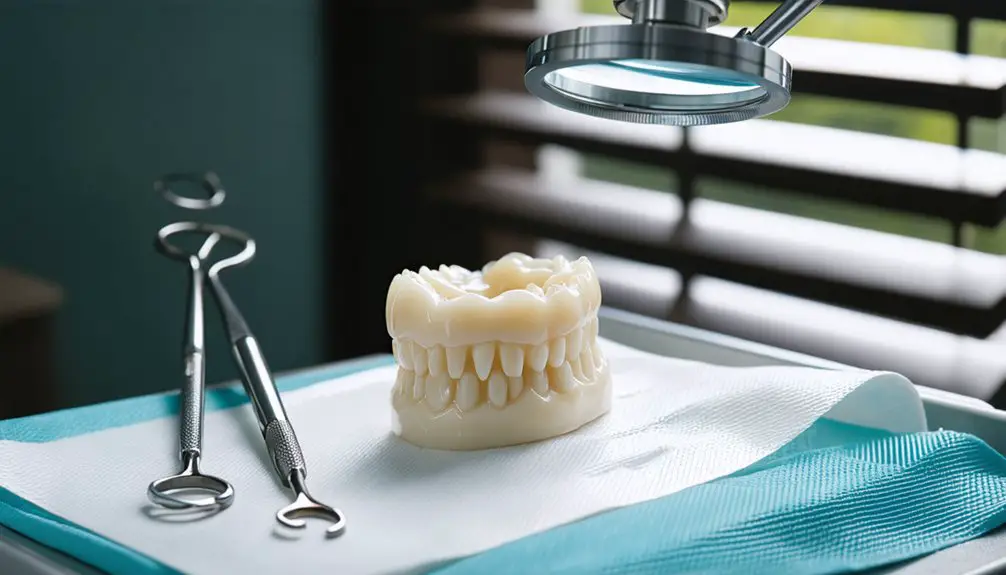
Before proceeding with any tooth whitening treatment, you’ll need to carry out essential pre-whitening dental checks to confirm patient safety and optimal results.
A thorough pre-whitening assessment involves evaluating both clinical and cosmetic considerations to prevent complications and guarantee ideal outcomes.
- Complete a detailed oral examination to identify decay, gum disease, or pathologies that may contraindicate whitening.
- Obtain necessary radiographs to detect hidden caries, assess bone levels, and identify any undiagnosed issues.
- Perform professional cleaning and polishing to remove surface stains and prepare teeth for maximum whitening effectiveness.
- Address all pending dental treatments, including filling repairs and periodontal issues, before initiating any whitening procedures.
Remember that successful whitening depends on establishing a stable foundation of oral health through these essential preparatory steps.
Best Practices for Safe Whitening With Dental Work
Safe tooth whitening for patients with dental restorations requires specialized protocols to protect existing dental work while achieving ideal results.
Successful tooth whitening with dental restorations demands careful attention to specialized techniques that safeguard existing work while delivering optimal whitening outcomes.
When implementing whitening strategies, you’ll need to carefully consider the type and concentration of bleaching agents. Use custom-fitted trays to minimize contact between whitening gel and restorative materials, and opt for lower concentrations of carbamide peroxide (10-20%) for at-home treatments.
Monitor your patients closely for sensitivity, especially around crowns and fillings. Apply desensitizing agents before and after treatment, and adjust application times as needed.
Avoid high-concentration hydrogen peroxide treatments on teeth with extensive restorations, as these can compromise restoration integrity.
Remember that existing dental work won’t whiten with bleaching, so you may need to plan for restoration replacement after whitening to achieve ideal color matching.
Frequently Asked Questions
How Long Should I Wait After Getting a Crown Before Whitening?
You’ll need to wait 2-4 weeks after crown placement before whitening to guarantee crown longevity and whitening safety. This allows dental cement to fully set and margins to properly stabilize.
Can Whitening Damage the Cement Holding My Crown in Place?
While you might worry about crown longevity, current research shows no direct evidence that whitening damages your crown’s cement. However, you’ll want professional supervision to guarantee whitening safety.
Will Insurance Cover Replacing Crowns That Don’t Match After Whitening?
No, your insurance won’t cover crown replacement after whitening since it’s considered cosmetic. Insurance coverage typically requires medical necessity and follows a 5-year replacement clause for existing crowns.
How Often Can I Safely Whiten if I Have Multiple Dental Restorations?
Like Dr. Smith’s patient who maintained bright results, you’ll want to whiten no more than twice yearly. For whitening safety and restoration compatibility, space treatments 6 months apart under professional supervision.
Should I Remove Temporary Crowns Before Starting a Whitening Treatment?
Yes, you’ll get better results by removing your temporary crowns before whitening. For ideal temporary crown safety and even whitening treatment results, consult your dentist about proper timing and removal procedures.
References
- https://www.cornerstonedentistryvan.com/the-hidden-dangers-of-teeth-whitening-treatments/
- https://www.dentistryofwestbend.com/teeth-whitening-risks-and-side-effects/
- https://pmc.ncbi.nlm.nih.gov/articles/PMC4058574/
- https://narrewarrendentalcare.com.au/dental-crowns-complications-dangers-that-may-occur-with-treatment/
- https://www.wysefamilydentistry.com/blog/2014/01/27/teeth-whitening-side-effects-and-139186/
- https://www.dentistpenntownship.com/will-teeth-whitening-affect-dental-crowns/
- https://www.longislandimplantdentistry.com/imported-rocky-point/does-teeth-whitening-affect-fillings-crowns-or-veneers/
- https://theivory.dental/dentist-news/whitening-fillings
- https://sportingsmiles.com/can-teeth-whitening-damage-fillings-or-crowns/
- https://www.pinewooddentistry.com/blog/can-you-whiten-crowns/
